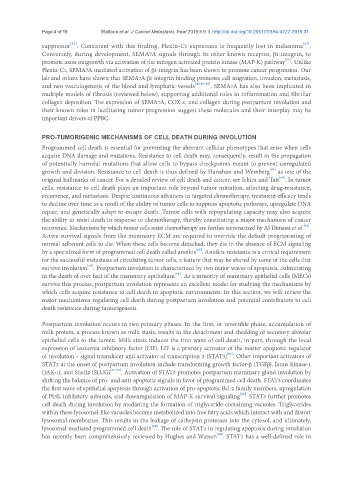Page 93 - Read Online
P. 93
Page 4 of 18 Wallace et al. J Cancer Metastasis Treat 2019;5:9 I http://dx.doi.org/10.20517/2394-4722.2019.01
[53]
[53]
suppressor . Consistent with this finding, Plexin-C1 expression is frequently lost in melanoma .
Conversely, during development, SEMA7A signals through its other known receptor, b1-integrin, to
[55]
promote axon outgrowth via activation of the mitogen activated protein kinase (MAP-K) pathway . Unlike
Plexin-C1, SEMA7A-mediated activation of b1-integrin has been shown to promote cancer progression. Our
lab and others have shown that SEMA7A-b1-integrin binding promotes cell migration, invasion, metastasis,
and neo-vasculogenesis of the blood and lymphatic vessels [49,56-58] . SEMA7A has also been implicated in
multiple models of fibrosis (reviewed below), supporting additional roles in inflammation and fibrillar
collagen deposition. The expression of SEMA7A, COX-2, and collagen during postpartum involution and
their known roles in facilitating tumor progression suggest these molecules and their interplay may be
important drivers of PPBC.
PRO-TUMORIGENIC MECHANISMS OF CELL DEATH DURING INVOLUTION
Programmed cell death is essential for preventing the aberrant cellular phenotypes that arise when cells
acquire DNA damage and mutations. Resistance to cell death may, consequently, result in the propagation
of potentially harmful mutations that allow cells to bypass checkpoints meant to prevent unregulated
[59]
growth and division. Resistance to cell death is thus defined by Hanahan and Weinberg as one of the
[60]
original hallmarks of cancer. For a detailed review of cell death and cancer, see Ichim and Tait . In tumor
cells, resistance to cell death plays an important role beyond tumor initiation, affecting drug-resistance,
recurrence, and metastasis. Despite continuous advances in targeted chemotherapy, treatment efficacy tends
to decline over time as a result of the ability of tumor cells to suppress apoptotic pathways, upregulate DNA
repair, and genetically adapt to escape death. Tumor cells with repopulating capacity may also acquire
the ability to resist death in response to chemotherapy, thereby constituting a major mechanism of cancer
[61]
recurrence. Mechanisms by which tumor cells resist chemotherapy are further summarized by Al-Dimassi et al. .
Active survival signals from the mammary ECM are required to override the default programming of
normal adherent cells to die. When these cells become detached, they die in the absence of ECM signaling
[62]
by a specialized form of programmed cell death called anoikis . Anoikis-resistance is a critical requirement
for the successful metastasis of circulating tumor cells, a feature that may be shared by some of the cells that
[63]
survive involution . Postpartum involution is characterized by two major waves of apoptosis, culminating
[64]
in the death of over half of the mammary epithelium . As a minority of mammary epithelial cells (MECs)
survive this process, postpartum involution represents an excellent model for studying the mechanisms by
which cells acquire resistance to cell death in apoptotic environments. In this section, we will review the
major mechanisms regulating cell death during postpartum involution and potential contributors to cell
death resistance during tumorigenesis.
Postpartum involution occurs in two primary phases. In the first, or reversible phase, accumulation of
milk protein, a process known as milk stasis, results in the detachment and shedding of secretory alveolar
epithelial cells to the lumen. Milk stasis induces the first wave of cell death, in part, through the local
expression of leukemia inhibitory factor (LIF). LIF is a primary activator of the master apoptotic regulator
[65]
of involution - signal transducer and activator of transcription 3 (STAT3) . Other important activators of
STAT3 at the onset of postpartum involution include transforming growth factor-b (TGFb), Janus kinase-1
(JAK-1), and Snail2 (SLUG) [66-68] . Activation of STAT3 promotes postpartum mammary gland involution by
shifting the balance of pro- and anti-apoptotic signals in favor of programmed cell death. STAT3 coordinates
the first wave of epithelial apoptosis through activation of pro-apoptotic Bcl-2 family members, upregulation
[66]
of PI3K inhibitory subunits, and downregulation of MAP-K survival signaling . STAT3 further promotes
cell death during involution by mediating the formation of triglyceride-containing vacuoles. Triglycerides
within these lysosomal-like vacuoles become metabolized into free fatty acids which interact with and distort
lysosomal membranes. This results in the leakage of cathepsin proteases into the cytosol, and ultimately,
[69]
lysosomal-mediated programmed cell death . The role of STAT3 in regulating apoptosis during involution
[66]
has recently been comprehensively reviewed by Hughes and Watson . STAT3 has a well-defined role in

